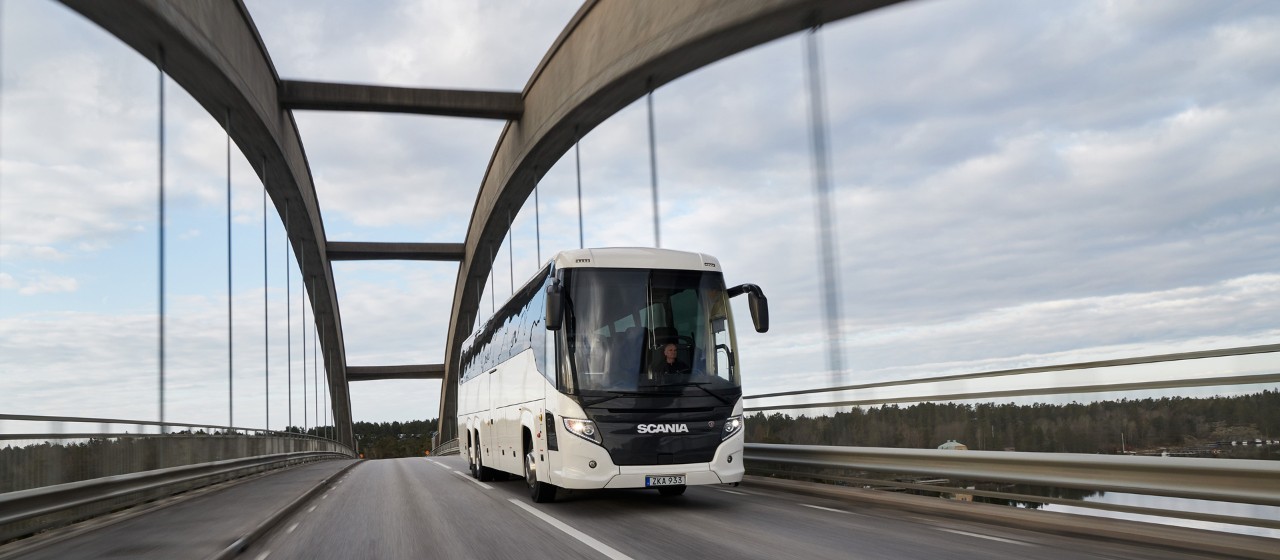
New Scania powertrain cuts coach companies’ fuel consumption and bills
17 SEPTEMBER 2021
With up to 5% less fuel consumption, coach operators should expect the most energy-efficient Scania coaches yet, which will also meet or even surpass emission targets.
It’s crucial for coach operators to minimise the fuel consumption of their vehicles. Fuel is one of the main contributors to the total cost of operation, and margins are tight.
A further challenge is adapting to tough new environmental laws restricting Nitrogen Oxide and CO2 emissions. And coach customers increasingly expect sustainable travel, too.
Choosing a cost-effective and energy-efficient bus has never been more important than it is now.
Up to 5% less fuel consumption, lower emissions
Scania understands these ‘pain points’, and has put fuel efficiency and lower emissions at the heart of the new Scania bus and coach generation. Three years of intensive R&D have produced fuel consumption savings of up to 5%, depending on emission class (Euro 6, Euro 5, etc).
“At the outset of this project we set a target of reducing fuel consumption for our travel coaches by an average of four to five percent from our previous model. I’m happy to say that we have achieved that, thanks mainly to the new powertrain,” says Niklas Berglund, Expert Engineer at Energy Consumption, Bus Chassis Development.
That the coaches are using the same types of driveline components from Scania trucks has also been beneficial.
“While the coach sector still lacks an equivalent energy use standard to city buses’ Standardised On-Road Test (SORT), the fact Scania trucks with these components have won the annual green truck award five years running, plus numerous other industry tests, means most comparisons in energy efficiency will be the same,” says Berglund.
The new engines also meet or even surpass the more stringent Eu6E emissions guidelines; reassuring for operators facing ever tighter regulations.
And, all Scania coaches and buses can be run on biofuel, a cleaner option and an important stepping stone on the way to fossil-free transport.
“An important step forward for Scania”
After three years of groundbreaking development, Scania is giving coach operators the most fuel-efficient, sustainable, comfortable and driveable vehicles yet.
“This is an important step forward for Scania. We have to lessen the amount of traffic that’s on the road, and buses have an incredibly important role to play in boosting public transport and sustainability,” says Berglund.
“My main hope from this new bus generation is that it will really open customers’ eyes to our tremendously good powertrain in terms of its energy consumption and emissions levels.
“And that they also understand that we can truly go not just nearer neutral in terms of fossil fuels, but switch to biofuels, where possible.”
THREE THINGS THAT MAKE SCANIA’S COACHES MORE FUEL-EFFICIENT:
1. Best-ever powertrain, including smaller, lighter engine:
The new powertrain is the result of a three-year development process. The 13-litre engine platform has been completely overhauled, including a new piston/ring package and the non-optional variable steering and variable coolant pumps. “And the smaller 9-litre engines have now been updated with regard to fuel efficiency and power, to meet the daily demands of competing in the travel coach sector,” says Niklas Berglund.
And, as Niklas Berglund adds: “The smaller 9-litre engines have now been updated not only in regards to fuel efficiency but also power, to meet the daily demands of the job and compete in the coach travel sector. Right sizing of the driveline will serve the customer with respect to less friction and less weight, giving them the possibilities of consuming even less energy or facilitating a possible increase in passenger capacity.”
2. Scania Opticruise:
The new coaches come with the Scania Opticruise automated manual gearbox, including cruise control with active prediction and lay shaft brake. “Scania Opticruise uses map data and GPS positioning to calculate and adjust for the most energy-efficient vehicle speed and gear shift strategy,” says Niklas Berglund.
3. Pulse & Glide function:
The new Cruise Control Active Production (CCAP) function ‘Pulse & Glide’, available in Economy mode, can reduce fuel consumption by up to 1%. The vehicle takes the data used by CCAP and uses it to determine and utilise the best efficiency area of engine speed and load.